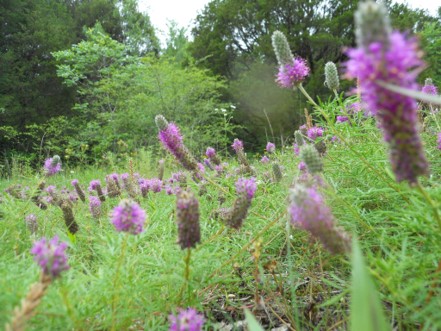by J. Brandon Fuller, doctoral student in Environment, Ecology & Energy Program, University of North Carolina at Chapel Hill
There is something about inconspicuous beauty that begs to be admired. Dalea,* or prairie clover, is an inconspicuous wiry shrub or sub-shrub, but the more Dalea I see, the more devoted I become. There are 165 species of Dalea in the New World from Canada to Argentina, with 75 of those species endemic to Mexico.1 Though a member of the pea/bean family (Fabaceae), the flowers of many species are small and arranged in heads, almost like a composite flower of the aster family. “Most people, upon seeing Dalea in flower, have no idea what family this is in, much less the genus or species,” note botanists Bruce Sorrie and Harry LeGrand.2
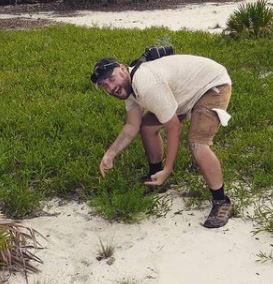
During most of the year, Dalea is an ugly duckling of a plant, easily overlooked by even the trained eye. Tom Diggs and I are collaborating on a phylogenetic study of Dalea, and on one collection trip we spent hours in the sweltering Florida sun in early August seeking D. feayi (Feay’s prairie clover). We tromped all through the Florida sandhills at Catfish Creek State Park without ever seeing it. Once we had finally admitted defeat and were headed back to our vehicle to depart, there it was… right next to the parking area in a small clearing. We had completely overlooked a plant that both of us were well trained to see! When I returned later in the season, the ugly ducklings had become glorious pink swans — plants with stunning blossoms easily found by both botanists and park visitors.
In the southeastern United States, Dalea comes in two “flavors:” purple flowers and white/pink flowers. The purple flavor can be found mostly in the limestone glades of Tennessee and Alabama and in remnant prairies further west. Dalea cahaba (Cahaba prairie clover) is a single-site endemic found only in Bibb County, Alabama. D. gattingeri (purpletassels), found in limestone cedar glades in north Alabama, Tennessee, and north Georgia, is wonderous to behold in full bloom. It is a small plant — no more than a foot high — that dominates the herbaceous layer in parts of the glades, and when it blooms the entire glade turns purple. That’s not an exaggeration! In July through August, head to the Bryant Grove section of Long Hunter State Park near Nashville, Tennessee to appreciate purpletassel’s fuchsia-colored petals accented by brilliant gold anthers.
D. foliosa (leafy prairie clover) can be found mostly in the central Tennessee limestone glades and is listed as an endangered species. D. foliosa is more robust with larger leaves than D. cahaba or D. gattingeri with a lighter shade of purple, and if you stumble across one of these striking plants, count yourself lucky as they are at risk of disappearing in the wild.3
D. purpurea (purple prairie clover) is more a shrub than a sub-shrub and is the most widespread of our southeastern Dalea. You can find D. purpurea in Tennessee, Alabama, Kentucky, and Mississippi and throughout the midwest and Canada. D. purpurea looks like the giant twin of D. cahaba and D. gattingeri with the same striking purple and gold flowers.
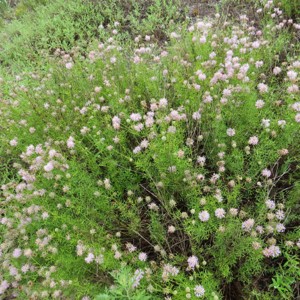
The white/pink flavors of Dalea, while not as showy as the purple flavors, are my personal favorites mostly due to habitat preference and their biogeography. I will start with the plant I mentioned at the beginning of this piece, as it’s my favorite — D. feayi (Feay’s prairie clover). This species occurs on the island ridges of central Florida4 and has bubblegum pink flowers with yellow to cream-colored anthers. The flower heads of D. feayi are round, so when in bloom it resembles pink bubbles floating through the air. The plant has revolute leaves which fold over to form little tubes which can retard water loss in the dry habitats in which they grow. It prefers to live in open sandy areas on ridge tops, pretty much a horrible place to live even for a dandelion, but Dalea thrives there! I think this tenacity and toughness paired with the delicate and soft flowers is what attracts me so much to D. feayi.
Other members of the white/pink flavors are D. pinnata (summer farewell), D. albida (whitetassels), and D. carnea (hammock prairie clover). D. albida and D. carnea, found in peninsular Florida, have white to pinkish flowers and are incredibly similar to the untrained eye, especially if it is a D. carnea with paler flowers. Steve Orzell, botanist at the Avon Park Air Force Range, taught me a nifty trick to tell the two apart: are their feet wet or not? D. albida likes it dry year-round while D. carnea can be found in the lower-lying seasonally wet areas.
D. pinnata is the only southeastern Dalea currently with varieties, var. pinnata and var. trifoliata, but that may change as growing evidence supports promoting these two to full species based on genetics, phenology, habitat, and morphology. Both varieties share the common name summer farewell due to their blooming time of late August into November. D. pinnata var. trifoliata occurs mostly in the Florida panhandle and coastal plain of Alabama and southwest Georgia. D. pinnata var. pinnata is the more widespread of the two and can be found throughout peninsular Florida and up into the coastal plain of the Carolinas.
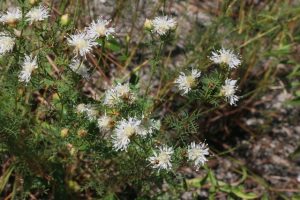
The North Carolina Natural Heritage Program lists Dalea pinnata var. pinnata as S2, “Imperiled due to rarity or some factor(s) making it very vulnerable to extirpation from the state. Typically 6-20 occurrences or few remaining individuals (1,000-3,000).” According to North Carolina botanists Bruce Sorrie and Harry LeGrand, summer farewell is “uncommon to infrequent in well-managed sites in the Sandhills, but mostly rare to locally uncommon in the region… Though there are many records for it, the species has clearly declined in recent decades owing to fire suppression of its pineland habitats, as well as to development, logging, and other factors. This is a species mainly limited to Longleaf Pine (Pinus palustris) sandhills, and within these habitats it favors somewhat loamy soils where there is a high diversity of herbaceous plants, as opposed to occurring on the drier sands. It tends to disappear from sites that have been fire suppressed for ten or more years, but does well in frequently burned sites, such as in managed conservation lands.”2
I hope you have gained a newfound respect and appreciation for this often overlooked but spectacular genus that comes in a variety of flavors. Dalea can have striking purple and gold flowers or whimsical bubblegum-pink bubbles. Dalea are tough and beautiful, some are incredibly rare, and some are more common. Dalea are habitat specialists so you won’t find them just anywhere. I hope you get to see these amazing plants in all their glory in a limestone cedar glade, sand ridge, or longleaf pine sandhill near your home or in your travels. Stop and take a closer look, and perhaps you too will become devoted to Dalea.
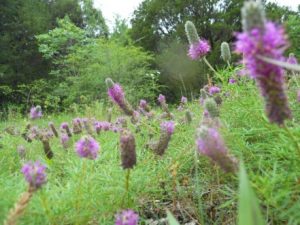
SOURCES:
- Estrada-Castillón AE; Villarreal-Quintanilla JA. (2008). “A new species of Daleasect. Parosela(Leguminosae: Papilionoideae: Amorpheae) from Durango, Mexico”. Brittonia. 60 (4): 332–35. doi:10.1007/s12228-008-9039-7
- LeGrand, H., B. Sorrie and T. Howard. 2021. Vascular Plants of North Carolina [Internet]. Raleigh (NC): North Carolina Biodiversity Project and North Carolina State Parks. Available from https://auth1.dpr.ncparks.gov/flora/index.php
- The Missouri Botanical Garden, in collaboration with the Center for Plant Conservation, maintains ex situ seed collections for use in research and as restoration material. https://saveplants.org/plant-profile/?CPCNum=1350
- I could devote an entire article to the biogeography of this region! For just a taste, see https://en.wikipedia.org/wiki/Lake_Wales_Ridge
* in older wildflower guides Dalea may be called Kuhnistera, Petalostemum or Petalostemon
